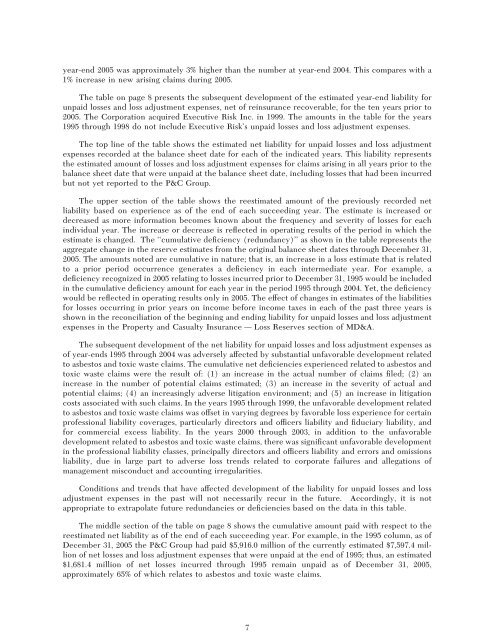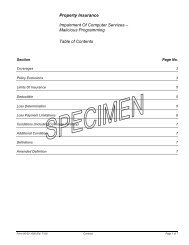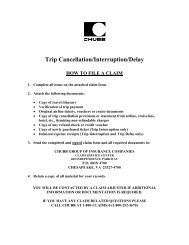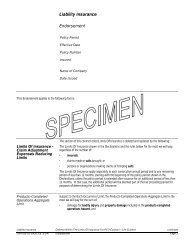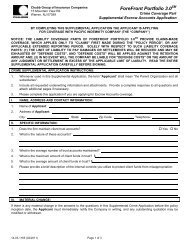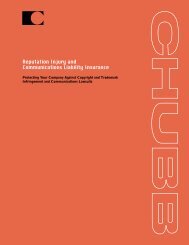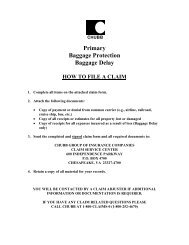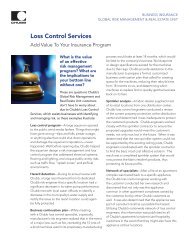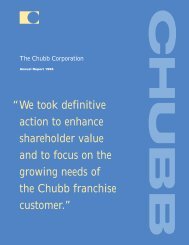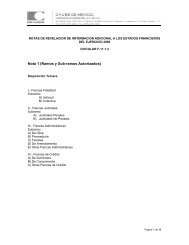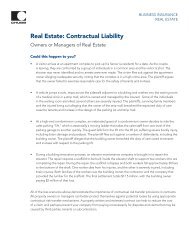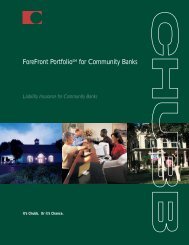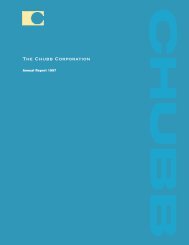Annual Report 2005 - Chubb Group of Insurance Companies
Annual Report 2005 - Chubb Group of Insurance Companies
Annual Report 2005 - Chubb Group of Insurance Companies
You also want an ePaper? Increase the reach of your titles
YUMPU automatically turns print PDFs into web optimized ePapers that Google loves.
year-end <strong>2005</strong> was approximately 3% higher than the number at year-end 2004. This compares with a<br />
1% increase in new arising claims during <strong>2005</strong>.<br />
The table on page 8 presents the subsequent development <strong>of</strong> the estimated year-end liability for<br />
unpaid losses and loss adjustment expenses, net <strong>of</strong> reinsurance recoverable, for the ten years prior to<br />
<strong>2005</strong>. The Corporation acquired Executive Risk Inc. in 1999. The amounts in the table for the years<br />
1995 through 1998 do not include Executive Risk's unpaid losses and loss adjustment expenses.<br />
The top line <strong>of</strong> the table shows the estimated net liability for unpaid losses and loss adjustment<br />
expenses recorded at the balance sheet date for each <strong>of</strong> the indicated years. This liability represents<br />
the estimated amount <strong>of</strong> losses and loss adjustment expenses for claims arising in all years prior to the<br />
balance sheet date that were unpaid at the balance sheet date, including losses that had been incurred<br />
but not yet reported to the P&C <strong>Group</strong>.<br />
The upper section <strong>of</strong> the table shows the reestimated amount <strong>of</strong> the previously recorded net<br />
liability based on experience as <strong>of</strong> the end <strong>of</strong> each succeeding year. The estimate is increased or<br />
decreased as more information becomes known about the frequency and severity <strong>of</strong> losses for each<br />
individual year. The increase or decrease is reÖected in operating results <strong>of</strong> the period in which the<br />
estimate is changed. The ""cumulative deÑciency (redundancy)'' as shown in the table represents the<br />
aggregate change in the reserve estimates from the original balance sheet dates through December 31,<br />
<strong>2005</strong>. The amounts noted are cumulative in nature; that is, an increase in a loss estimate that is related<br />
to a prior period occurrence generates a deÑciency in each intermediate year. For example, a<br />
deÑciency recognized in <strong>2005</strong> relating to losses incurred prior to December 31, 1995 would be included<br />
in the cumulative deÑciency amount for each year in the period 1995 through 2004. Yet, the deÑciency<br />
would be reÖected in operating results only in <strong>2005</strong>. The eÅect <strong>of</strong> changes in estimates <strong>of</strong> the liabilities<br />
for losses occurring in prior years on income before income taxes in each <strong>of</strong> the past three years is<br />
shown in the reconciliation <strong>of</strong> the beginning and ending liability for unpaid losses and loss adjustment<br />
expenses in the Property and Casualty <strong>Insurance</strong> ÌLoss Reserves section <strong>of</strong> MD&A.<br />
The subsequent development <strong>of</strong> the net liability for unpaid losses and loss adjustment expenses as<br />
<strong>of</strong> year-ends 1995 through 2004 was adversely aÅected by substantial unfavorable development related<br />
to asbestos and toxic waste claims. The cumulative net deÑciencies experienced related to asbestos and<br />
toxic waste claims were the result <strong>of</strong>: (1) an increase in the actual number <strong>of</strong> claims Ñled; (2) an<br />
increase in the number <strong>of</strong> potential claims estimated; (3) an increase in the severity <strong>of</strong> actual and<br />
potential claims; (4) an increasingly adverse litigation environment; and (5) an increase in litigation<br />
costs associated with such claims. In the years 1995 through 1999, the unfavorable development related<br />
to asbestos and toxic waste claims was oÅset in varying degrees by favorable loss experience for certain<br />
pr<strong>of</strong>essional liability coverages, particularly directors and oÇcers liability and Ñduciary liability, and<br />
for commercial excess liability. In the years 2000 through 2003, in addition to the unfavorable<br />
development related to asbestos and toxic waste claims, there was signiÑcant unfavorable development<br />
in the pr<strong>of</strong>essional liability classes, principally directors and oÇcers liability and errors and omissions<br />
liability, due in large part to adverse loss trends related to corporate failures and allegations <strong>of</strong><br />
management misconduct and accounting irregularities.<br />
Conditions and trends that have aÅected development <strong>of</strong> the liability for unpaid losses and loss<br />
adjustment expenses in the past will not necessarily recur in the future. Accordingly, it is not<br />
appropriate to extrapolate future redundancies or deÑciencies based on the data in this table.<br />
The middle section <strong>of</strong> the table on page 8 shows the cumulative amount paid with respect to the<br />
reestimated net liability as <strong>of</strong> the end <strong>of</strong> each succeeding year. For example, in the 1995 column, as <strong>of</strong><br />
December 31, <strong>2005</strong> the P&C <strong>Group</strong> had paid $5,916.0 million <strong>of</strong> the currently estimated $7,597.4 million<br />
<strong>of</strong> net losses and loss adjustment expenses that were unpaid at the end <strong>of</strong> 1995; thus, an estimated<br />
$1,681.4 million <strong>of</strong> net losses incurred through 1995 remain unpaid as <strong>of</strong> December 31, <strong>2005</strong>,<br />
approximately 65% <strong>of</strong> which relates to asbestos and toxic waste claims.<br />
7


